Bicycles
Traffic Rules for Cyclists
When you cycle on Québec roads, most of the traffic rules that apply to road vehicles also apply to bicycles. However, some rules apply specifically to cyclists, whether they use a regular or electric bike.
How to Ride a Bicycle
When riding a bicycle on a public road, you must:
- be seated astride, which is to say, with one leg on each side of the seat;
- keep hold of the handlebars; and
- carry no animals or objects that obstruct your vision or interfere with your riding.
When two or more people are riding, they must ride one in the back of another. A maximum of 15 cyclists are allowed to ride in a line on a public road.
Before making a turn, you must signal your intention continuously and for a long enough distance, unless the manoeuvre would put your safety at risk.
To signal your intention of turning:
- left: place your left arm horizontally;
- right: place your right arm horizontally or raise your left forearm vertically.
Places to Ride a Bicycle
You can ride your bicycle on the road, a shoulder, a bike lane, a shared street and, in some circumstances, a sidewalk.
On the road
On the road, you must ride your bicycle:
- in the direction the vehicles are driving or in the way indicated by a sign for cyclists;
- as close as possible to the curb or right side of the road, considering the condition of the roadway and the risk of being hit by the open door of a stopped vehicle; and
- to the left of a lane reserved for right turns if you wish to continue straight.
To make a left turn, however, you can use the part of the road that makes your manoeuvre easiest.
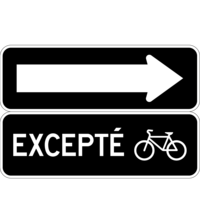
Sign indicating a one-way street that cyclists are not required to follow
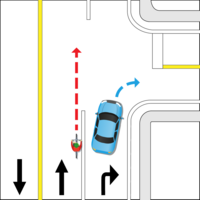
Example of a cyclist wishing to continue straight and who must move to the left of a right-turning reserved lane
Visit the Obstacles and Road Surfaces page of the Société de l’assurance automobile du Québec (SAAQ) to learn more about how to drive when obstacles and slippery roadways are present.
On a bicycle route
On bicycle routes, some specific rules apply to protect the cyclists’ movements and safety. For more information, visit the Bicycle Route page.
On the sidewalk
It is not permitted to ride your bicycle on the sidewalk unless a sign requires or allows it.
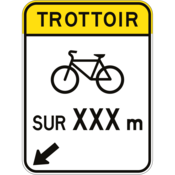
Sign indicating that cyclists may share the sidewalk with pedestrians for a specified distance
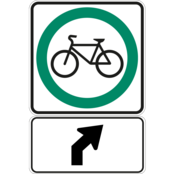
Sign for cyclists indicating that they must use a specific route, in this case the sidewalk
When using the sidewalk, cyclists must ride at a safe and reasonable speed and give way to pedestrians. There is not specific speed, as it varies according to various factors, including:
- the presence of pedestrians;
- the width of the sidewalk;
- the environment’s design; and
- other obstacles that may impede traffic flow or obstruct visibility.
When approaching a pedestrian, you should reduce your speed and make sure, if possible, that they have seen or heard you.
You may pass or cross a pedestrian only if there is enough space.
On a shared street
When riding on a shared street, the same traffic rules apply as on the rest of the road. Pedestrians always have the right of way. To learn more, visit the Shared Street page.
On a bikeway
A bikeway is a lane designed specifically for bicycles for better convenience and safety.
You can’t ride a bicycle:
- on a limited access road like a highway or its entry or exit points;
- on a sidewalk, except where necessary, or unless a sign authorizes or requires it; and
- anywhere where a sign prohibits it.
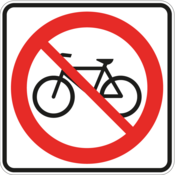
Sign indicating that it is forbidden to ride a bicycle
Children under the age of 12 are not permitted to ride on a roadway where the speed limit is greater than 50 km/h unless one of the following conditions is met:
- the bicycle lane is separated from the roadway by a physical barrier; and
- they are participating in an activity supervised by a person who is 18 years or older.
Last update: November 1, 2023


